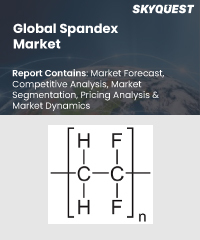
Report ID: SQMIG25M2043

Report ID:
SQMIG25M2043 |
Region:
Global |
Published Date: February, 2024
Pages:
157
|
Tables:
63 |
Figures:
75
Spandex Market size was valued at USD 6.12 Billion in 2021 and is poised to grow from USD 6.71 Billion in 2022 to USD 13.87 Billion by 2030, at a CAGR of 9.51% during the forecast period (2023-2030).
The global spandex market has experienced significant growth in recent years and is expected to continue expanding in the coming years. Spandex, also known as elastane, is a synthetic fibre renowned for its exceptional elasticity, stretchability, and durability. It finds widespread applications in various industries, including textiles, sportswear, swimwear, undergarments, and medical garments. One of the key drivers fueling the growth of the global spandex market is the increasing demand for comfortable and stretchable fabrics. Spandex offers superior elasticity and recovery properties, providing a snug and flexible fit in clothing. With the rising popularity of athleisure and activewear trends, the demand for stretchable fabrics has surged, driving the adoption of spandex in sportswear and casual clothing.
Additionally, the growing awareness of health and fitness, coupled with changing lifestyles and increased participation in sports and recreational activities, has spurred the demand for performance-driven apparel. Spandex offers moisture-wicking properties, breathability, and enhanced comfort, making it a preferred choice for performance-oriented garments. Moreover, the rising disposable incomes and improving standards of living in emerging economies have resulted in increased consumer spending on clothing and fashion. The fashion industry's continuous evolution and the demand for stylish and well-fitting clothing have further propelled the growth of the spandex market. However, the global spandex market also faces several challenges. One of the primary challenges is the volatility of raw material prices. The main raw material for spandex production is polyurethane, and fluctuations in the price of polyurethane can impact the overall manufacturing costs of spandex fibres. Fluctuating raw material prices can pose challenges for manufacturers in terms of cost management and profitability. Another challenge is the environmental impact associated with spandex production and disposal. Spandex is a synthetic fibre derived from petrochemicals, and its production involves energy-intensive processes. Additionally, the disposal of spandex products can contribute to waste and environmental pollution. Increasing environmental concerns and regulations related to sustainability and circular economy practices pose challenges for the spandex industry to adopt more eco-friendly manufacturing processes and promote recycling initiatives.
US Spandex Market is poised to grow at a sustainable CAGR for the next forecast year.
Our industry expert will work with you to provide you with customized data in a short amount of time.
REQUEST FREE CUSTOMIZATIONWant to customize this report? This report can be personalized according to your needs. Our analysts and industry experts will work directly with you to understand your requirements and provide you with customized data in a short amount of time. We offer $1000 worth of FREE customization at the time of purchase.

Report ID: SQMIG25M2043